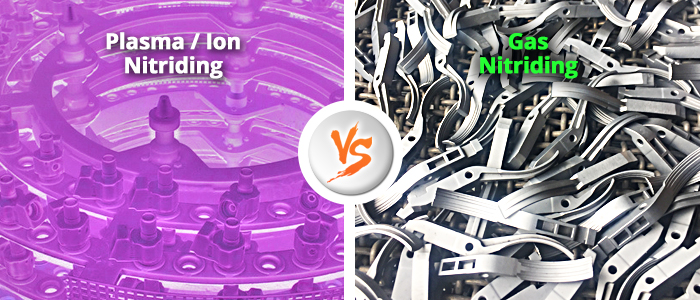Many interesting articles have been written about the differences between Gas and Plasma (Ion) nitriding, and how these technologies have greatly improved over the years and surmounted many of the problems encountered in the past. Today, they are complementary in many ways, but neither is the solution for everything. One has to weigh the benefits and shortcomings before using either method.
Nitrex Metal is more than a supplier of turnkey nitriding installations; we also operate a large international network of commercial heat-treating centers. While we offer the largest gas nitriding capacity in the US, we also offer a significant amount of ion (plasma) nitriding services as well. Given our accumulated experience with both technologies over the years, we thought it interesting to elaborate on the differences between these two.
As stated previously, ion (plasma) or gas nitriding each have their own ideal applications, but neither of them is a panacea for all applications. For instance, ion nitriding is the only choice for nitriding powder metallurgy parts with low density, and it is also very efficient for parts with very large masking surfaces, while gas nitriding is unbeatable with low and medium carbon steel as well as cast iron.
When considering emission control, it’s important to clarify a misconception. Even though gas nitriding uses ammonia in the process atmosphere, there are high efficiency neutralizers like the Nitrex IN Series that eliminate the effluent gas problem and thus make the process compliant to the most stringent international emission standards. In the case of ion (plasma) nitriding, it needs to be mentioned that although it does not use ammonia in the process, it uses nitrogen and hydrogen, which by reverse reaction produces ammonia at the exhaust end of the furnace.
When comparing the two technologies, it’s also important to note the following;
- the requirements of batch washing are very similar for both technologies
- the preparation of a batch is much simpler for a gas process, and therefore the preparation costs in most cases are lower
- ion proponents assert that a traditional gas nitriding furnace, even with automatic control, can consume up to 100 times more than an ion furnace. This, however, is incorrect with respect to the advanced Nitrex technology. A Nitrex furnace consumes a very similar amount of gas to what an ion one does for a comparable batch.
- another argument is the shorter processing time possible with ion. This also is incorrect when compared to an advanced Nitrex system where process times from floor-to-floor are shorter.
- for the cost and financial benefits of each, an important element for users is CAPEX and ROI. The initial investment cost for an ion installation and a very good quality gas nitriding system like Nitrex is comparable. The difference in ROI is 2-3 times faster in advanced gas than in an ion system with the assumption that the selling price is the same per part treated. This is possible thanks to the ability of gas furnace to carry a heavier load, processing 2-3 times the density of an ion charge, and the ability to obtain the highest homogeneity and repeatability.
- due to the lack of basic elements of thermochemical control, which perhaps does not constitute a major obstacle for repetitive loads, but is definitely a major difficulty for varying charges, ion (plasma) nitriding requires operators with very high qualifications. With Nitrex gas nitriding, on the contrary, the operator is not involved in any technological decisions, therefore his/her knowledge and expertise are not essential.
We hope that this article has shed further light on the subject of nitriding and will instigate even more interest in these technologies. If you would like to learn more, do not hesitate to contact Nitrex Metal.


